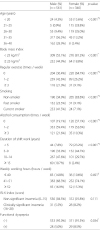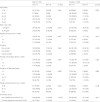2. Tack J, Talley NJ, Camilleri M, Holtmann G, Hu P, Malagelada JR, et al. Functional gastroduodenal disorders. Gastroenterology. 2006; 130:1466–1479. DOI:
10.1053/j.gastro.2005.11.059. PMID:
16678560.

4. Miwa H, Kusano M, Arisawa T, Oshima T, Kato M, Joh T, et al. Evidence-based clinical practice guidelines for functional dyspepsia. J Gastroenterol. 2015; 50:125–139. DOI:
10.1007/s00535-014-1022-3. PMID:
25586651.

5. Henningsen P, Zimmermann T, Sattel H. Medically unexplained physical symptoms, anxiety, and depression: a meta-analytic review. Psychosom Med. 2003; 65:528–533. DOI:
10.1097/01.PSY.0000075977.90337.E7. PMID:
12883101.
6. Haug TT, Mykletun A, Dahl AA. Are anxiety and depression related to gastrointestinal symptoms in the general population? Scand J Gastroenterol. 2002; 37:294–298. DOI:
10.1080/003655202317284192. PMID:
11916191.

7. Sauter SM, Murphy L, Colligan M, Swanson N, Hurrell J, Scharf F, et al. STRESS...At Work. US National Institute for Occupational Safety and Health, DHHS (NIOSH) Publication. 1999. p. 1–25.
8. Chang SJ, Koh SB, Kang MG, Cha BS, Park JK, Hyun SJ, et al. Epidemiology of psychosocial distress in Korean employees. J Prev Med Public Health. 2005; 38:25–37. PMID:
16312907.
9. Huston M, Larsen RC. LaDou J, Harrison RJ, editors. Occupational Mental Health & Workplace Violence. Current Diagnosis & Treatment: occupational and environmental medicine. 2014. New York: McGraw-Hill Education;p. 622–623.
10. Melchior M, Caspi A, Milne BJ, Danese A, Poulton R, Moffitt TE. Work stress precipitates depression and anxiety in young, working women and men. Psychol Med. 2007; 37:1119–1129. DOI:
10.1017/S0033291707000414. PMID:
17407618.

11. Park KC, Lee KJ, Park JB, Min KB, Lee KW. Association between occupational stress and depression, anxiety, and stress symptoms among white-collar male workers in an automotive company. Korean J Occup Environ Med. 2008; 20:215–224.

13. Huerta-Franco M-R, Vargas-Luna M, Tienda P, Delgadillo-Holtfort I, Balleza-Ordaz M, Flores-Hernandez C. Effects of occupational stress on the gastrointestinal tract. World J Gastrointest Pathophysiol. 2013; 4:108–118. DOI:
10.4291/wjgp.v4.i4.108. PMID:
24244879.
14. Konturek PC, Brzozowski T, Konturek SJ. Stress and the gut: pathophysiology, clinical consequences, diagnostic approach and treatment options. J Physiol Pharmacol. 2011; 62:591–599. PMID:
22314561.
16. Chang SJ, Koh SB, Kang D, Kim SA, Kang MG, Lee CG, et al. Developing an occupational stress scale for Korean employees. Korean J Occup Environ Med. 2005; 17:297–317.

17. Kang SH, Boo YJ, Lee JS, Ji WB, Yoo BE, You JY. Analysis of the occupational stress of Korean surgeons: a pilot study. J Korean Surg Soc. 2013; 84:261–266. DOI:
10.4174/jkss.2013.84.5.261. PMID:
23646310.

18. Choi YI, Kim EJ, Park EY. Validity of the Korean occupational stress scale in occupational therapists. J Korea Contents Association. 2011; 11:225–233. DOI:
10.5392/JKCA.2011.11.7.225.

19. Cho YW, Song ML, Morin CM. Validation of a Korean version of the insomnia severity index. J Clin Neurol. 2014; 10:210–215. DOI:
10.3988/jcn.2014.10.3.210. PMID:
25045373.

20. Song KH, Jung HK, Min BH, Youn YH, Choi KD, Keum BR, et al. Development and validation of the Korean Rome III questionnaire for diagnosis of functional gastrointestinal disorders. J Neurogastroenterol Motil. 2013; 19:509–515. DOI:
10.5056/jnm.2013.19.4.509. PMID:
24199012.

21. Sobreira LF, Zucoloto S, Garcia SB, Troncon LE. Effects of myenteric denervation on gastric epithelial cells and gastric emptying. Dig Dis Sci. 2002; 47:2493–2499. DOI:
10.1023/A:1020508009213. PMID:
12452385.
22. Quintana E, Hernandez C, Alvarez-Barrientos A, Esplugues JV, Barrachina MD. Synthesis of nitric oxide in postganglionic myenteric neurons during endotoxemia: implications for gastric motor function in rats. FASEB J. 2004; 18:531–533. DOI:
10.1096/fj.03-0596fje. PMID:
14715697.
24. Mawdsley JE, Rampton DS. Psychological stress in IBD: new insights into pathogenic and therapeutic implications. Gut. 2005; 54:1481–1491. DOI:
10.1136/gut.2005.064261. PMID:
16162953.

25. Sagami Y, Shimada Y, Tayama J, Nomura T, Satake M, Endo Y, et al. Effect of a corticotropin releasing hormone receptor antagonist on colonic sensory and motor function in patients with irritable bowel syndrome. Gut. 2004; 53:958–964. DOI:
10.1136/gut.2003.018911. PMID:
15194643.

26. Mak A. D. P., Wu J. C. Y., Chan Y., Chan F. K. L., Sung J. J. Y., Lee S.. Dyspepsia is strongly associated with major depression and generalised anxiety disorder - a community study. Alimentary Pharmacology & Therapeutics. 2012; 36(8):800–810. DOI:
10.1111/apt.12036. PMID:
22957985.

27. Van Oudenhove L, Aziz Q. The role of psychosocial factors and psychiatric disorders in functional dyspepsia. Nat Rev Gastroenterol Hepatol. 2013; 10:158. DOI:
10.1038/nrgastro.2013.10. PMID:
23358396.

28. Koloski NA, Talley NJ, Boyce PM. A history of abuse in community subjects with irritable bowel syndrome and functional dyspepsia: the role of other psychosocial variables. Digestion. 2005; 72:86–96. DOI:
10.1159/000087722. PMID:
16127275.

29. Haug TT, Wilhelmsen I, Berstad A, Ursin H. Life events and stress in patients with functional dyspepsia compared with patients with duodenal ulcer and healthy controls. Scand J Gastroenterol. 1995; 30:524–530. DOI:
10.3109/00365529509089784. PMID:
7569758.

30. Chang Boon Lee P. Going beyond career plateau: using professional plateau to account for work outcomes. J Manag Dev. 2003; 22:538–551. DOI:
10.1108/02621710310478503.
31. Huerta-Franco MR, Vargas-Luna M, Montes-Frausto JB, Morales-Mata I, Ramirez-Padilla L. Effect of psychological stress on gastric motility assessed by electrical bio-impedance. World J Gastroenterol. 2012; 18:5027–5033. DOI:
10.3748/wjg.v18.i36.5027. PMID:
23049210.

32. Rothenbacher D, Peter R, Bode G, Adler G, Brenner H. Dyspepsia in relation to helicobacter pylori infection and psychosocial work stress in white collar employees. Am J Gastroenterol. 1998; 93:1443. DOI:
10.1111/j.1572-0241.1998.00460.x. PMID:
9732922.

33. Lihm HS, Park SH, Gong EH, Choi JS, Kim JW. Relationship between occupational stress and gastric disease in male workers. Korean J Fam Med. 2012; 33:311–319. DOI:
10.4082/kjfm.2012.33.5.311. PMID:
23115706.

34. Jang SH, Ryu HS, Choi SC, Lee SY. Psychological factors influence the irritable bowel syndrome and their effect on quality of life among firefighters in South Korea. Psychiatry Investig. 2017; 14:434–440. DOI:
10.4306/pi.2017.14.4.434.

35. Huerta R, Brizuela-Gamino OL. Interaction of pubertal status, mood and self-esteem in adolescent girls. J Reprod Med. 2002; 47:217–225. PMID:
11933687.
36. Nakadaira H, Yamamoto M, Matsubara T. Mental and physical effects of Tanshin funin, posting without family, on married male workers in Japan. J Occup Health. 2006; 48:113–123. DOI:
10.1539/joh.48.113. PMID:
16612040.
37. Gentry LA, Chung J, Aung N, Keller S, Heinrich KM, Maddock J. Gender differences in stress and coping among adults living in Hawaii. Calif J Health Promot. 2007; 5:89–102.

38. Drossman DA, Li Z, Andruzzi E, Temple RD, Talley NJ, Thompson WG, et al. U.S. householder survey of functional gastrointestinal disorders. Prevalence, sociodemography, and health impact. Dig Dis Sci. 1993; 38:1569–1580. DOI:
10.1007/BF01303162. PMID:
8359066.
39. Tougas G, Chen Y, Hwang P, Liu MM, Eggleston A. Prevalence and impact of upper gastrointestinal symptoms in the Canadian population: findings from the DIGEST study. Domestic/International Gastroenterology Surveillance Study. Am J Gastroenterol. 1999; 94:2845–2854. DOI:
10.1111/j.1572-0241.1999.01427.x. PMID:
10520832.








 PDF
PDF Citation
Citation Print
Print



 XML Download
XML Download